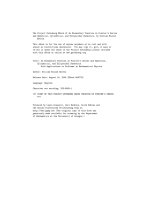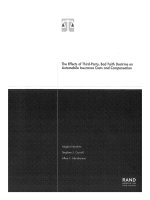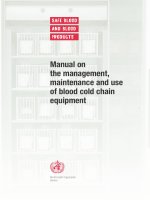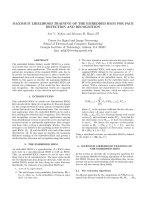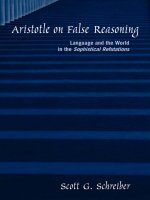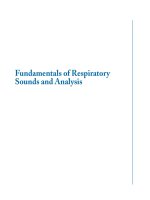Mid-infrared laser-spectroscopic sensing of chemical species
Bạn đang xem bản rút gọn của tài liệu. Xem và tải ngay bản đầy đủ của tài liệu tại đây (1.08 MB, 5 trang )
Journal of Advanced Research (2015) 6, 529–533
Cairo University
Journal of Advanced Research
LETTER TO THE EDITOR
Mid-infrared laser-spectroscopic sensing
of chemical species
Markus W. Sigrist
ETH Zu¨rich, Institute for Quantum Electronics, Laser Spectroscopy and Sensing Laboratory, Otto-Stern-Weg 1,
CH-8093 Zu¨rich, Switzerland
A R T I C L E
I N F O
Article history:
Received 5 August 2014
Received in revised form 23
September 2014
Accepted 29 September 2014
Available online 13 October 2014
A B S T R A C T
This letter reports on mid-infrared laser-based detection and analysis of chemical species.
Emphasis is put on broadly tunable laser sources and sensitive detection schemes. Selected
examples from our lab illustrate the performance and potential of such systems in various areas
including environmental and medical sensing.
ª 2014 Production and hosting by Elsevier B.V. on behalf of Cairo University.
Keywords:
Mid-IR lasers
Spectroscopy
Gas sensing
Surgical smoke
Glucose
Introduction
In the recent years spectroscopic schemes have made significant progress thanks to new developments in lasers and detection techniques. Today, laser-based sensing of chemical species
offers high sensitivity and specificity, large dynamic range,
multi-component capability, and lack of pretreatment or preconcentration. The availability of broadly tunable mid-infrared sources – particularly in the important 3–4 lm
wavelength range – such as quantum cascade lasers (QCLs)
E-mail address:
Peer review under responsibility of Cairo University.
Production and hosting by Elsevier
[1–4], tunable radiation generated by nonlinear optical processes such as difference frequency generation (DFG) [5,6]
and optical parametric oscillators (OPOs) [5,7,8], interband
cascade diode lasers (ICLs) [9–11], distributed feedback
(DFB) diode lasers [12,13], or the most recent development
of diode-pumped lead salt vertical external cavity surface emitting lasers (VECSELs) [14,15] has certainly eased the implementation of laser-based sensing devices.
Furthermore, detection schemes such as multipass absorption, cavity-enhanced and cavity-ringdown or photoacoustic
detection are by now well-established techniques so that their
implementation has become straightforward.
In the last years we have developed laser-spectroscopic systems in our laboratory for various applications in different
areas ranging from environmental and industrial to medical
and forensic fields. The description of some selected examples
illustrates the performance and potential of laser spectroscopic
sensing.
2090-1232 ª 2014 Production and hosting by Elsevier B.V. on behalf of Cairo University.
/>
530
M.W. Sigrist
Trace gas detection
The first example concerns environmental gas sensing. Some
time ago we implemented a photoacoustic system consisting
of two line-tunable CO2 lasers (12CO2 and 13CO2) covering
the spectral range between 9.2 and 11.4 lm and a home-made
multipass resonant photoacoustic cell equipped with 16 microphones for signal enhancement.
The entire system is fully automated and built in a mobile
trailer and has been used unattended for extended periods of
time (see Fig. 1). As example, one-week concentration profiles
of ethene (C2H4), ammonia (NH3) and CO2 have been
recorded in 1-min intervals at the roadside location at the exit
of a street tunnel to evaluate street traffic emissions [16]. This
was achieved by automatic switching between different laser
transitions of the two lasers that are characteristic for strong
absorption of these gases yet avoiding spectral interferences.
Regularly, the modulation frequency of the chopper switched
to a (strongly) absorbing water line to check its matching with
the acoustic resonance frequency of the cell. As a result, the
concentration profiles followed the traffic density and reached
rather high maximum values of 2000 ppm for CO2, 400 ppb for
ethene and up to 600 ppb for ammonia. These data were used
to evaluate mean emission data of 200 g kmÀ1 vehicleÀ1 for
Fig. 2 Image of operation theater in the University Hospital
Zurich during minimal invasive surgery with electroknife (LigaSure). Collection of smoke and CO2 in Tedlar bags for subsequent
laser-spectroscopic analysis in our lab.
CO2, 26 mg kmÀ1 vehicleÀ1 for ethene and 31 mg kmÀ1 vehicleÀ1 (for LDV: low-duty vehicles) or 14 mg kmÀ1 vehicleÀ1
(for HDV: high-duty vehicles) for ammonia. Obviously, one
would strongly miniaturize such a system today by replacing
the CO2 lasers with modern semiconductor lasers.
A second example concerns first measurements with a novel
lead-salt VECSEL (vertical extended cavity surface emitting
laser). The VECSEL is pumped with a near-IR diode laser
and tuning is performed by simply applying a voltage ramp
(0–100 V) on the VECSEL piezo element. The main features
are a broad and fast tuning, e.g., between 2950 cmÀ1 and
3100 cmÀ1 within 2 s. This wavelength range is of special interest in petrochemical industry and other areas for monitoring,
e.g., C1–C4 alkanes (i.e., methane, ethane, propane and
butanes) in gas mixtures. With this laser source and a simple
multipass absorption cell we achieved sub-ppm detection limits
for all these hydrocarbons in mixtures even in the presence of a
high water vapor content.
Analysis of surgical smoke
Fig. 1 Inside of automated mobile CO2-laser photoacoustic
system for field monitoring of air pollutants: lower left: sealed-off
12
CO2- and 13CO2 lasers side by side and home-built photoacoustic cell in the back.
A further example of gas sensing concerns a medical application, namely the analysis of surgical smoke that is produced
during minimal-invasive surgery with an electro-knife [17,18].
This study was done in collaboration with the University hospital in Zurich. There is an ongoing controversial discussion on
compounds present in the smoke that could be potentially hazardous for the medical personnel and/or the patient. Since
Mid-infrared laser-spectroscopic sensing of chemical species
531
Table 1 Detected chemical compounds in the 31 measured samples of surgical smoke. Listed are seven substances with their
concentrations in ppm. LOD: limit of detection, REL: recommended exposure limit.
Substance
No. of samples
Median concentration
Range of concentrations
LOD (ppm)
REL (ppm)
Carbon monoxide (CO)
Hydrogen fluoride (HF)
Sevoflurane (C4H3F7O)
Methane (CH4)
Ethane (C2H6)
Ethylene (C2H4)
Water vapor (H2O), abs.
6
6
27
27
27
27
27
0.85
<0.00011
110
0.39
<0.1
<5
0.61%
<0.25–3.20
<0.00011
<20–450
<0.1–34.0
<0.1–2.0
<5–10
0.27–1.1%
0.25
0.00011
20
0.1
0.1
5
–
30
1
2a
104
104
104
–
a
No REL value for Switzerland. The US Institute for Occupational Safety and Health recommends exposure limits of 2 ppm for all
halogenated anesthetics.
Fig. 3
Homebuilt IR-fiber-coupled photoacoustic cell for non-invasive glucose measurements. See text for details.
most previous studies were performed in vitro, we made the
first in vivo experiments with laser spectroscopy on smoke samples that we collected in Tedlar bags during the course of several operations (see Fig. 2). We recorded infrared spectra of
the samples with a home-made broadly tunable DFG system
[19] in our laboratory with the exception of CO recording
which was performed with a diode-laser-based system [17].
The spectral analysis was then performed with a principal
component analysis [20]. Besides water vapor, mainly traces
of methane, ethane, ethylene, and – surprisingly high concentrations of up to 450 ppm – of the anesthetic gas sevoflurane
were found in varying concentrations. As listed in Table 1 all
concentrations with the exception of sevoflurane were below
recommended exposure limits [18].
Toward non-invasive in vivo glucose sensing
With some 600 million patients worldwide, Diabetes mellitus is
a widespread human metabolic disease. Since currently no
treatment exists, the therapy consists in monitoring the blood
glucose concentration of a patient and adjusting it to near-normal levels of 60–120 mg/dl. This implies measurements of the
blood glucose level several times a day which is rather uncomfortable. Since no non-invasive method exists up to now
despite intense research with numerous techniques, the measurement still involves finger pricking to take small blood samples. We made some first steps toward the goal of non-invasive
glucose monitoring by developing a new scheme based on midinfrared laser photoacoustic spectroscopy. As laser source we
used an external cavity quantum cascade laser (EC-QCL) tunable in the range around 1000 cmÀ1 where glucose exhibits two
strong absorption peaks (at 1034 cmÀ1 and 1080 cmÀ1). The
main problem of the mid-IR range is the strong water absorption in the tissue. This limits the penetration depth through
skin to approximately 50 lm, i.e. blood vessels cannot be
reached but instead the interstitial fluid within the epidermis
whose glucose level is related to the blood glucose level with
some time delay of 10–30 min can be accessed. We developed
a new fiber-coupled photoacoustic (PA) cell which is directly
brought into contact with the sample, e.g. the skin at the
human forearm [21]. Fig. 3 depicts the details of the PA cell
with the mid-IR fiber (AgClBr) inlet, the small air volume of
only 35 mm3 for detecting the PA signal with an electret microphone, a relative humidity and temperature (RH-T) sensor and
a dry air or N2 flow to keep the humidity in the air chamber
low.
We performed numerous measurements on various samples: aqueous solutions of glucose [22], solutions of keratinocytes (skin cells), epidermal skin samples [23] and in vivo
human skin. By setting the QCL to the 1034 cmÀ1 glucose
absorption peak we recorded the PA signal for various glucose concentrations for determining limit of detection
(LOD). We achieved an LOD of 30 mg/dl (for SNR = 1)
for aqueous glucose solutions, and an LOD of 50 mg/dl
(SNR = 1) for keratinocytes solutions. By placing epidermal
skin samples in direct contact with aqueous glucose solutions
we were able to monitor the time-resolved diffusion of glucose into the skin sample (LOD = 100 mg/dl (SNR = 1))
[23]. Finally we monitored the PA signal as a function of time
532
during an oral glucose tolerance test (OGTT) in vivo by placing the PA cell in direct contact with the human forearm of
volunteers. Our preliminary results look promising although
some main issues such as remaining instabilities of the PA
measurements and the limited detection sensitivity which is
close to expected glucose concentration changes during an
OGTT need yet to be addressed.
An alternative method for investigating strongly scattering
samples such as tissue could be a novel technique that we
developed named Photothermal Diffuse Reflection (PTDR)
Spectroscopy [24]. This method combines the advantages of
the selective strong absorption in the mid-infrared with the
excellent detection sensitivity in the near-infrared in a non-contact configuration.
Conclusions
Laser-spectroscopic techniques offer unique possibilities for
monitoring chemical species which is demonstrated with examples from multi-component gas sensing in environmental or
medical applications such as urban air monitoring or surgical
smoke analysis. In both cases a narrowband broadly tunable
IR laser is essential for achieving high selectivity down to the
sub-ppb concentration range. On the other hand, a novel
approach with a QCL-based photoacoustic sensor toward
non-invasive glucose monitoring through human skin is presented. First in vivo tests appear promising but further research
and development is definitely needed to actually demonstrate
the feasibility of this method.
A vast literature is available on laser-based chemical sensing. This short summary of own projects is just meant to illustrate some main features and possibilities but also limitations
of this technique. The main issue remains the availability of
appropriate broadly tunable laser sources and sensitive detection schemes. Hence, the development of new laser types
enables new possibilities, e.g., more field capabilities in ambient and industrial monitoring or point-of-care instrumentation
in medical applications. It can also be foreseen that new areas
of application for laser-based sensors will open up.
Conflict of interest
The author has declared no conflict of interest.
Compliance with Ethics Requirements
This article does not contain any studies with human or animal
subjects.
Acknowledgements
The author thank his coworkers D. Marinov, M. Gianella, J.
Rey and J. Kottmann for their valuable contributions as well
as Dr. D. Hahnloser (University Hospital Zurich) for the fruitful collaboration within the frame of the surgical smoke project and Drs. J. Luginbu¨hl and E. Reichmann (Children
Hospital Zurich) for providing keratinocyte solutions and epidermal skin samples for the glucose Project. Funding by the
M.W. Sigrist
Swiss National Science Foundation, ETH Zurich and Glucometrix is greatly acknowledged.
References
[1] Riedi S, Hugi A, Bismuto A, Beck M, Faist J. Broad band
external cavity tuning in the 3–4 lm window. Appl Phys Lett
2013;103:031108.
[2] Rao GN, Karpf A. External cavity tunable quantum cascade
lasers and their applications to trace gas monitoring. Appl Opt
2011;50:A100–15.
[3] Reyes-Reyes A, Hou Z, van Mastrigt E, Horsten RC, de Jongste
JC, Pijnenburg MW, et al. Multicomponent gas analysis using
broadband quantum cascade laser spectroscopy. Opt Express
2014;22:18299.
[4] Bandyopadhyay N, Bai Y, Tsao S, Nida S, Slivken S, Razeghi
M. Room temperature continuous wave operation of k $ 3–
3.2 lm quantum cascade lasers. Appl Phys Lett 2012;101:
241110.
[5] Sorokina IT, Vodopyanov KL, editors. Solid-state midinfrared laser sources. Topics in applied physics. Berlin
Heidelberg: Springer; 2003. p. 89.
[6] Sigrist MW, Wa¨chter H, Gianella M. Generation of coherent
mid-infrared radiation by difference-frequency mixing. In:
Tra¨ger F, editor. Springer handbook of lasers and
optics. Berlin Heidelberg: Springer; 2012 [chapter 11.10].
[7] Borsutzky A, L’Huillier JA. Optical parametric oscillators. In:
Tra¨ger F, editor. Springer handbook of lasers and optics. Berlin
Heidelberg: Springer; 2012 [chapter 11.9].
[8] Arslanov DD, Spunei M, Mandon J, Cristescu SM, Persijn ST,
Harren FJM. Continuous-wave optical parametric oscillator
based infrared spectroscopy for sensitive molecular gas sensing.
Laser Photonics Rev 2013;7:188–206.
[9] Bewley WW, Canedy CL, Kim CS, Kim M, Merritt CD,
Abell J, et al. High-power room-temperature continuous-wave
mid-infrared interband cascade lasers. Opt Express 2012;20:
20894.
[10] Bauer A, Dallner M, Kamp M, Ho¨fling S, Worschech L,
Forchel A. Shortened injection interband cascade lasers for 3.3–
3.6 lm-emission. Opt Eng 2010;49:111117.
[11] Kim M, Canedy CL, Bewley WW, Kim CS, Lindle JR, Abell J,
et al. Interband cascade laser emitting at in continuous wave
above room temperature. Appl Phys Lett 2008;92:191110.
[12] Naehle L, Belahsene S, von Edlinger M, Fischer M, Boissier G,
Grech P, et al. Continuous-wave operation of type I quantum
well DFB laser diodes emitting in the 3.4 lm wavelength range
around room temperature. Electron Lett 2011;47:46–7.
[13] Krzempek K, Lewicki R, Na¨hle L, Fischer M, Koeth J,
Belahsene S, et al. Continuous wave distributed feedback
diode laser-based sensor for trace-gas detection of ethane.
Appl Phys B 2012;106:251–5.
[14] Fill M, Debernardi P, Felder F, Zogg H. Lead-chalcogenide
mid-infrared vertical external cavity surface emitting lasers with
improved threshold: theory and experiment. Appl Phys Lett
2013;103:201120.
[15] Rahim M, Khiar A, Felder F, Fill M, Zogg H, Sigrist MW. 5lm vertical cavity surface-emitting laser (VECSEL) for
spectroscopic applications. Appl Phys B 2010;100:261–4.
[16] Marinov D, Sigrist MW. Monitoring of road-traffic emission
with mobile photoacoustic system. Photochem Photobiol Sci
2003;2:774–8.
[17] Gianella M, Sigrist MW. Chemical analysis of surgical smoke by
infrared laser spectroscopy. Appl Phys B 2012;109:485–96.
[18] Gianella M, Hahnloser D, Rey JM, Sigrist MW. Quantitative
chemical analysis of surgical smoke generated during laparoscopic
surgery. Surg Innov 2014;21:170–9.
Mid-infrared laser-spectroscopic sensing of chemical species
[19] Gianella M, Sigrist MW. Automated broad tuning of difference
frequency sources for spectroscopic studies. Appl Opt
2011;50(4):A11–9.
[20] Gianella M, Sigrist MW. Improved algorithm for quantitative
analyses of infrared spectra of multicomponent gas mixtures
with unknown composition. Appl Spectrosc 2009;63:338–43.
[21] Kottmann J, Grob U, Rey JM, Sigrist MW. Mid-infrared fibercoupled photoacoustic sensor for biomedical applications.
Sensors 2013;13:535–49.
533
[22] Kottmann J, Rey J, Sigrist MW. New photoacoustic cell
design for studying aqueous samples. Rev Sci Instrum
2011;82:084903.
[23] Kottmann J, Rey JM, Luginbu¨hl J, Reichmann E, Sigrist MW.
Glucose sensing in human epidermis using mid-infrared
photoacoustic detection. Biomed Opt Express 2012;3(4):667–80.
[24] Rey JM, Kottmann J, Sigrist MW. Photothermal diffuse
reflectance: a new tool for spectroscopic investigation of
scattering samples. Appl Phys B 2013;112:547–51.

